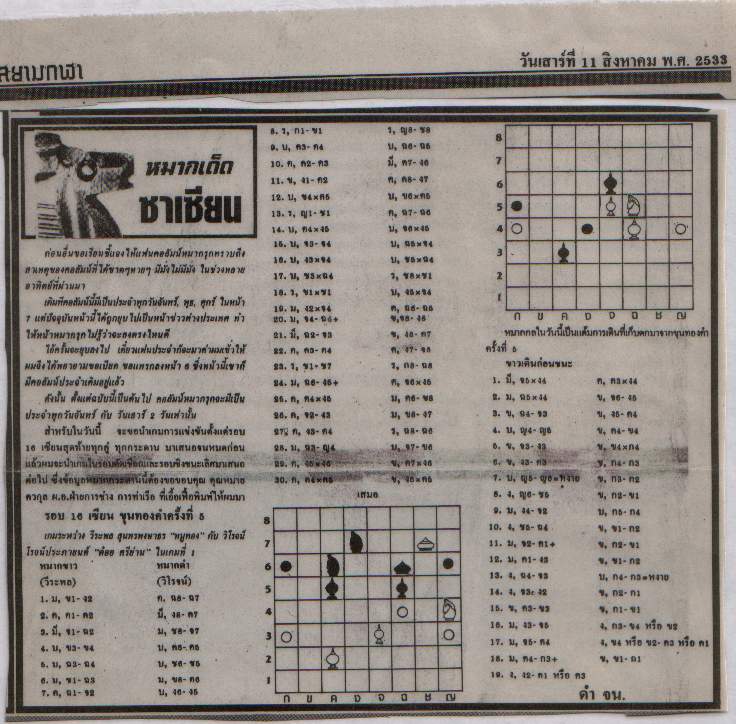
Thai Chess is the game which is probably the closest to the original form of chess.

|
The rules of the game of Thai Chess are that the rook moves like a rook, the knight moves like a knight, and the king moves like a king. The pawn moves almost the same as a pawn, except that it starts on the third rank, not the second, and therefore cannot move two squares forward on the first move.
The major differences are that the bishop in Thai Chess moves like a silver general in shogi (which is Japanese chess). This means that the bishop moves exactly one square diagonally or one square forward, but cannot move one square directly backward or sideways.
The queen in Thai Chess moves exactly one square diagonally only.
The pawn in Thai chess promotes to a queen on reaching the sixth rank (not the eighth rank). However, remember that in Thai Chess the queen is a weak piece. As a result, promotions are much more common and a player frequently has several queens on the board in Thai chess.
The pieces are set up the same as in International chess, except that the pawns start on the third rank and the king and queen on the white side are reversed, so that a king faces his opponent's enemy queen. This means that the two queens, which move diagonally only, can eventually capture each other.
The rules of checkmate are the same. However, the Thai equivalent of the fifty move draw rule is much more complex. In Thai Chess, the player with the stronger side is given points for each piece he has left on the board and, the more points he has, the quicker he must mate to avoid a draw. For example, in the endgame of king and two rooks against a lone king, the player with the two rooks must mate in just four moves. However, if the lone king is near the center of the board or attacking an undefended rook, there are positions in which it is impossible to mate in four. Thus, if a situation arises in which there is a king and two rooks against a king and only one rook, the player with only one rook may be able to force a draw by sacrificing his lone remaining rook.
Here is the most common opening in Thai Chess:
1. Bc1-c2 Bf8-f7 2. Nb1-d2 Ng8-e7 3. f3-f4 c6-c5 4. Ng1-f3 Nb8-c6 5. e3-e4 d6-d5 6. Qe1-f2 Qd8-c7 7. Qf2-e3 Qc7-d6 8. Bf1-f2 Bc8-c7 9. Kd1-e2 Ke8-d7 10. b3-b4 g6-g5
This is approximately the Ruy Lopez, Closed Variation, of Thai Chess.
I have considered writing a book on Thai Chess because I have the game scores of the games played by the winners of the recent national championships played in Bangkok of Thai Chess. I need to find out how much interest there would be in such a book.
Here are two games played in the 1990 Thailand National Championship in Bangkok, in which I participated. The two best players have been for many years Suchart Chaivichit and Veeraphol Sunthornpongsathorn. These have also been the two best players of Western Chess. Suchart has been rated as high as 2420 FIDE, whereas Veeraphol has been rated as high as 2330 FIDE.
In this tournament, Suchart and Veeraphol again met in the championship finals and Suchart, as usual, was the winner.
[Event "Thailand Championship"]
[Site "Bangkok (Thailand)"]
[Date "1990.??.??"]
[Round "?"]
[White "Fufuengmongkolkij Kiart"]
[Black "Chaivichit Suchart"]
[Result "0-1"]
1. Nb1-d2 Qd8-c7 2. Ng1-e2 c6-c5 3. Bc1-c2 Ng8-e7 4. Qd1-f2 Bf8-f7 5. b3-b4 Nb8-c6 6. e3-e4 d6-d5 7. Qf2-e3 g6-g5 8. Bf1-f2 h6-h5 9. b4xc5 b6xc5 10. h3-h4 g5-g4 11. f3xg4 h5xg4 12. e4xd5 e6xd5 13. Nd2-b3 Qc7-d6 14. c3-c4 Bf7-e6 15. c4xd5 Be6xd5 16. Bc2-c3 Bc8-d7 17. Qe3-f4 Bd7-e6 18. Bf2-e3 Ke8-d7 19. Kd1-c2 Ra8-c8 20. Kc2-d2 Rc8-b8 21. Ra1-b1 Ne7-c8 22. Be3-e4 Nc8-b6 23. Be4xd5 Be6xd5 24. Rh1-c1 Rh8-e8 25. Nb3-a1 Qd6-e5 26. Qf4-e3 Kd7-d6 27. Na1-c2 Nb6-a4 28. Nc2-e1 Rb8-b1 29. Rc1xb1 Qe5-d4 30. Qe3xd4 c5xd4 31. Bc3-b2 Nc6-e5 32. Bb2-b3 Na4-b5 33. Ne2-f4 Ne5-f3 34. Ne1xf3 g4xf3=Q 35. Nf4xd5 Re8-e2 36. Kd2-d1 Kd6xd5 37. Bb3-c4 Kd5-c6 38. Bc4xc5 Kc6xc5 39. Rb1-c1+ Kc5-d5 40. Rc1-c8 Re2-e6 41. Rc8-d8 Kd5-e5 42. Kd1-c2 f6-f5 43. Kc2-d2 Qf3-g4 44. Kd2-c2 Re6-c6 45. Kc2-d2 Rc6-d6+ 46. Rd8xd6 Kd5xd6 {White Resigns} 0-1
[Event "Thailand Championship"]
[Site "Bangkok (Thailand)"]
[Date "1990.??.??"]
[Round "?"]
[White "Sunthornpongsathorn Veeraphol"]
[Black "Nakorn"]
[Result "1/2-1/2"]
1. Nb1-d2 Bf8-f7 2. Bc1-c2 f6-f5 3. Qe1-f2 Bc8-b7 4. e3-e4 Qd8-e7 5. d3-d4 Nb8-d7 6. Qf2-e3 Qe7-f6 7. Bc2-d3 b6-b5 8. Kd1-c2 a6-a5 9. Bf1-f2 Ng8-e7 10. Ng1-e2 c6-c5 11. d4xc5 Nd7xc5 12. Qe3-d4 Nc5-d7 13. a3-a4 b5-b4 14. c3xb4 a5xb4 15. Kc2-b2 e6-e5 16. Qd4-e3 Bf7-e6 17. Bd3-c4 Bb7-c6 18. Ne2-c1 Ke8-f7 19. Nc1-d3 Ra8-b8 20. a4-a5 d6-d5 21. e4xd5 Be6xd5 22. a5-a6=Q e5-e4 23. f3xe4 f5xe4 24. Nd3-f4 g6-g5 25. Nf4xd5 Bc6xd5 26. Qa6-b5 Nd7-e5 27. Bc4xd5 Ne7xd5 28. Qb5-c4 Nd5-b6 29. Qe3-d4 Nb6xc4 30. b3xc4 Ne5-d3 31. Kb2-b3 Nd3xf2 32. Rh1-f1 Rh8-d8 33. Ra1-a7+ Kf7-g6 34. Rf1xf2 Rd8xd4 35. Ra7-a6 Rb8-f8 36. Nd2-f1 Rd4-d3 37. Kb3xb4 Rd3-f3 38. Rf2xf3 e4xf3=Q 39. Nf1-e3 a6-a5 40. c4-c5 Rf8-e8 41. Nd3-e5 Re8-f8 42. c5-c6=Q Kg6-f5 43. Qc6-d7 Qf6-e5 44. Kb4-c5 Kf5-d4 45. Ra6-h6 Rf8-a8 46. Nd5-c3 Ke4-d3 47. Nc3-b5 Ra8-d8 {Agreed draw} 1/2-1/2
Games of Thai Chess are often published in the daily newspapers or even broadcast on TV. Here is a typical newspaper clipping.
 |